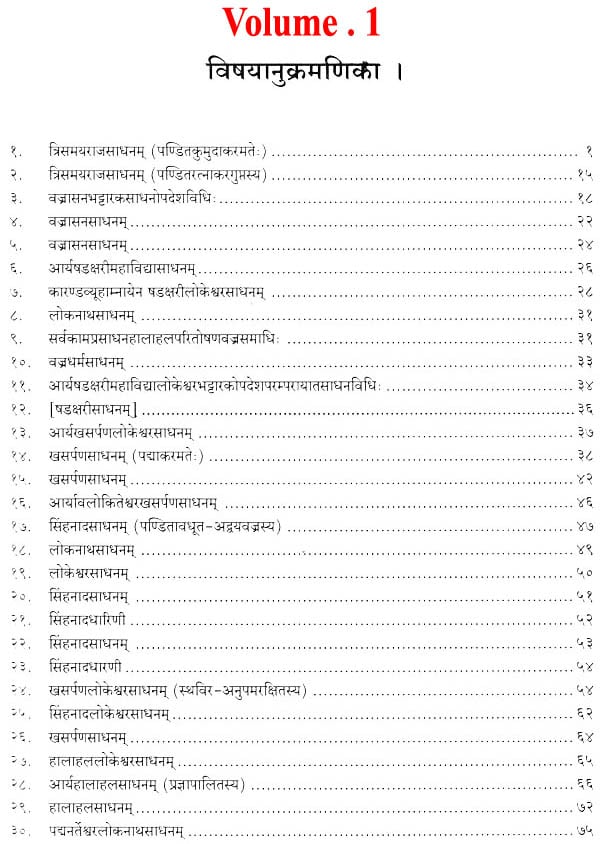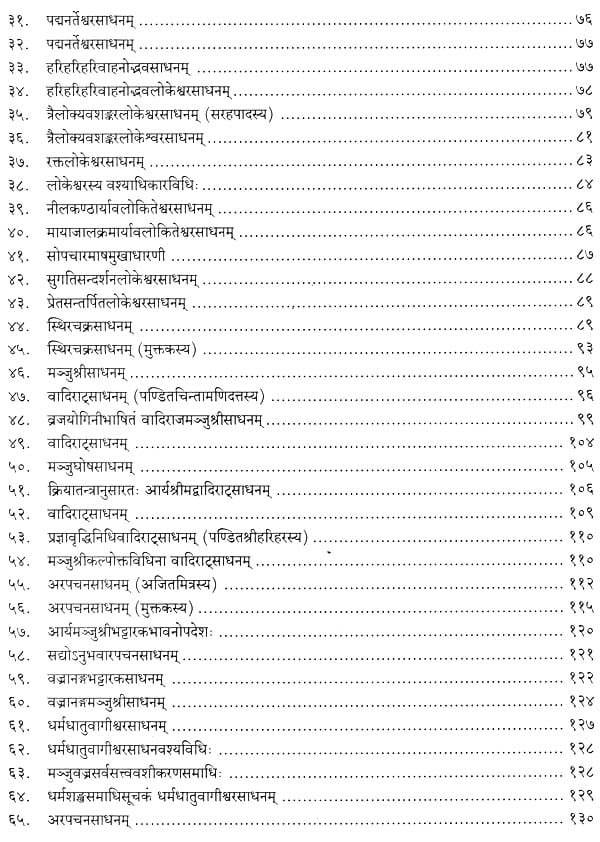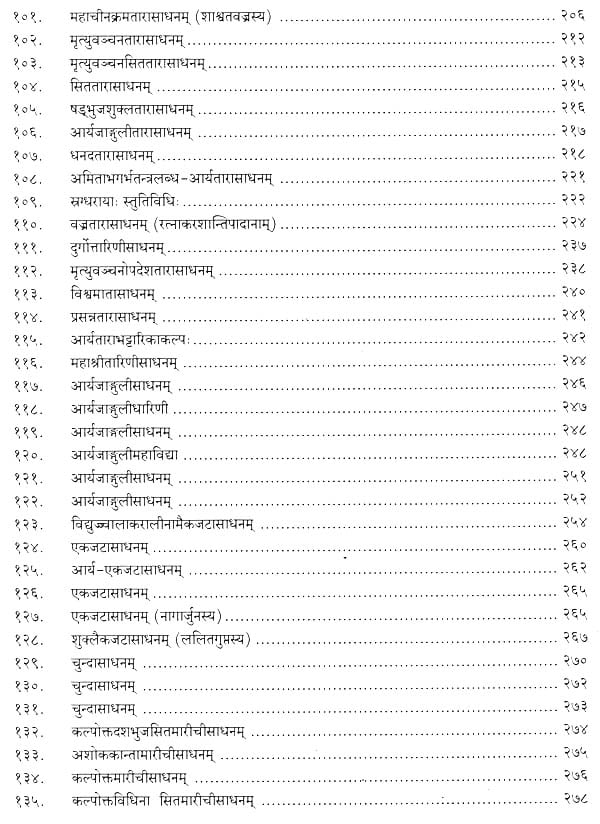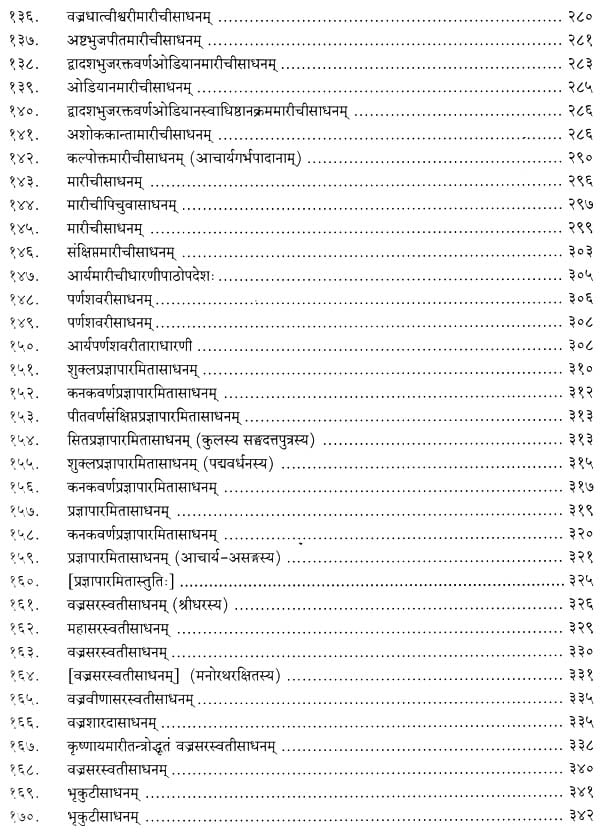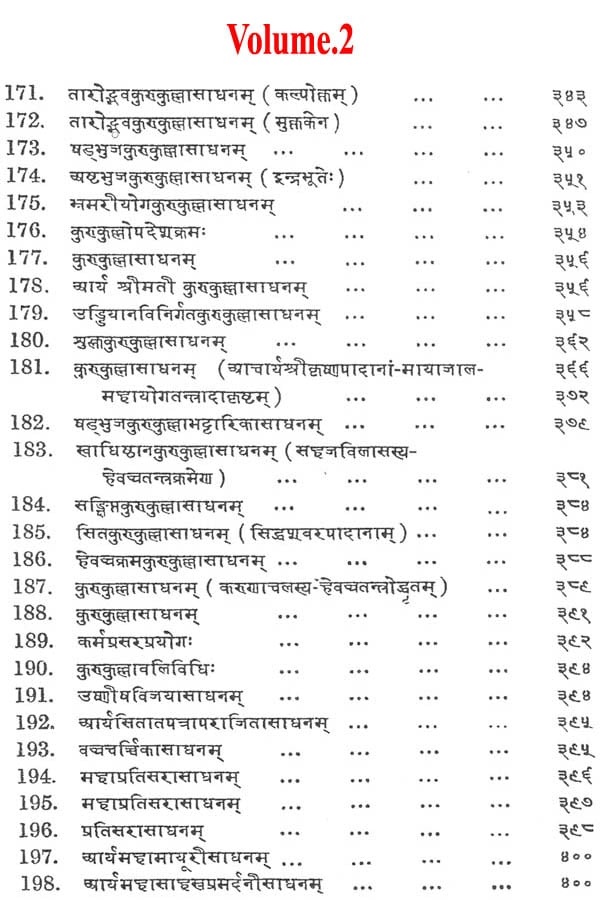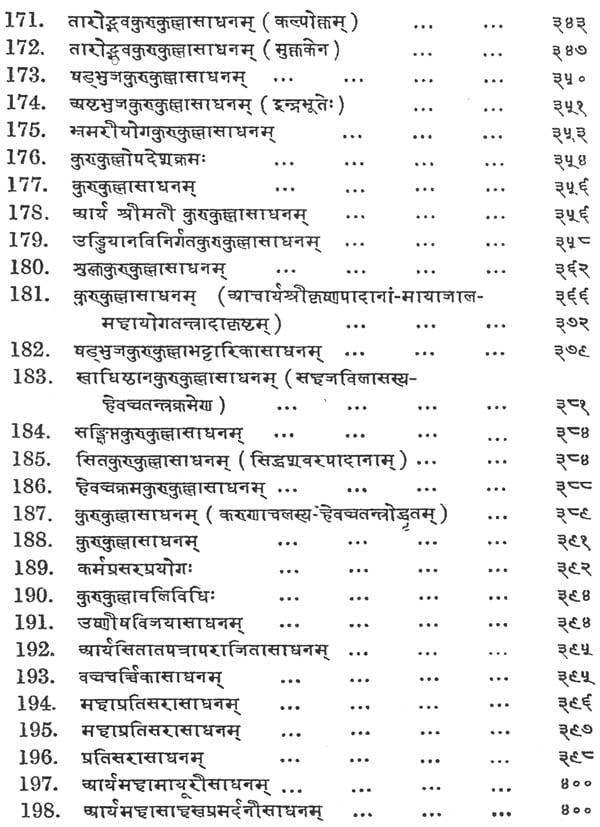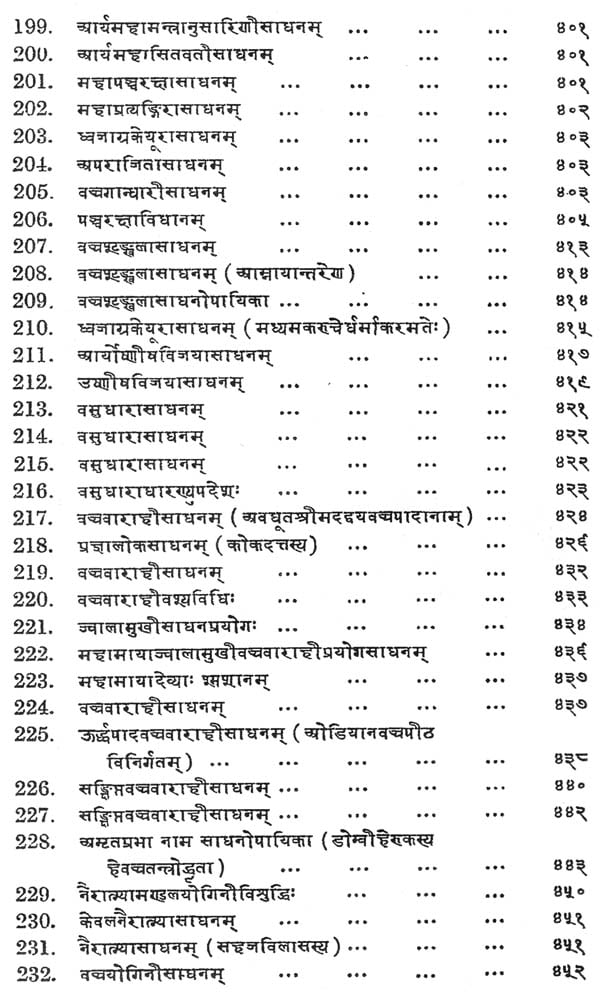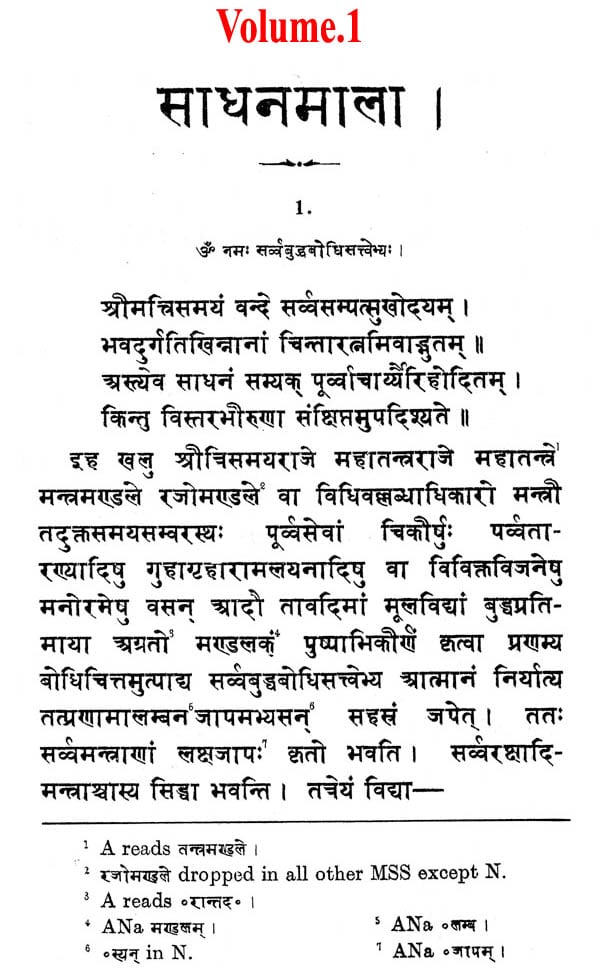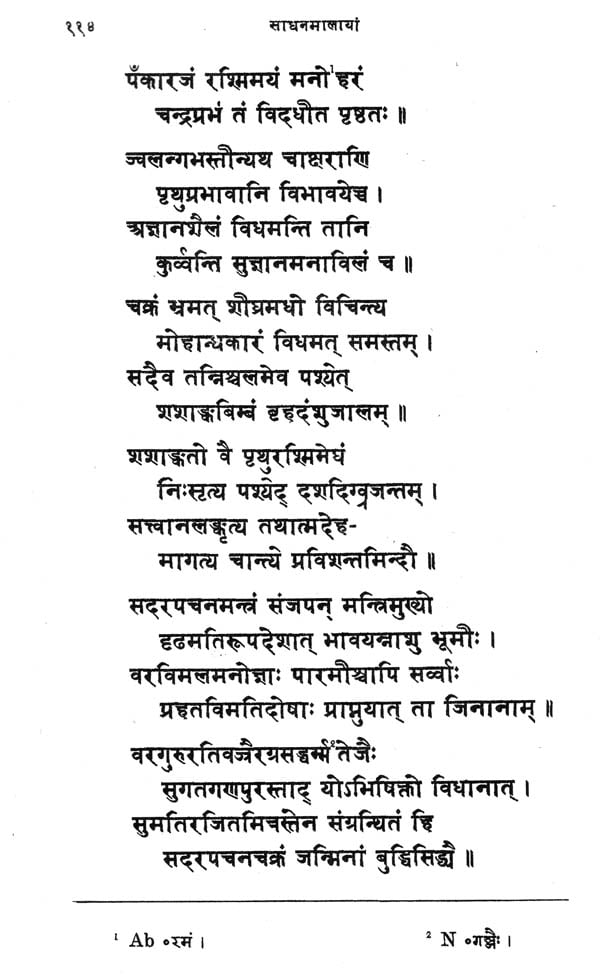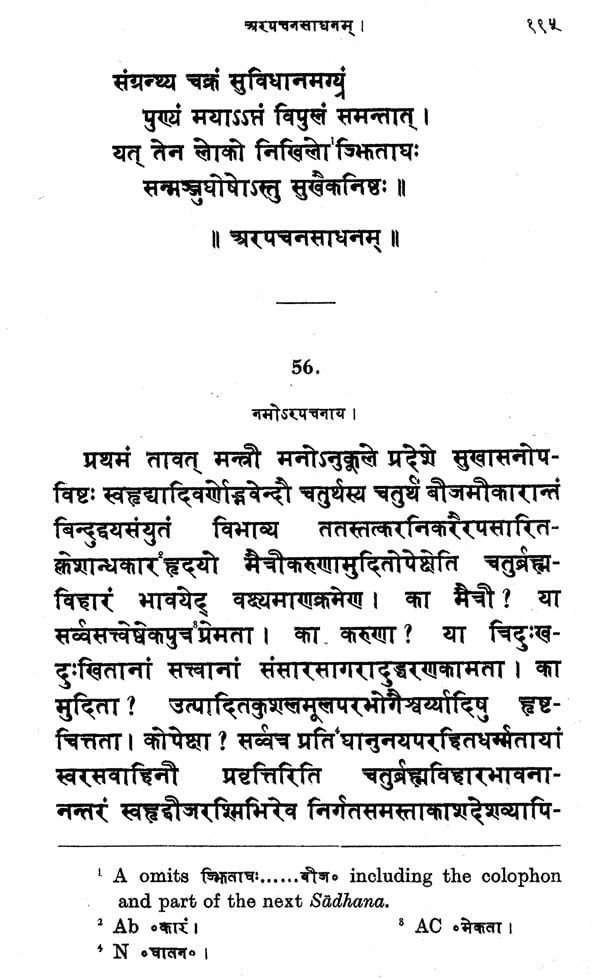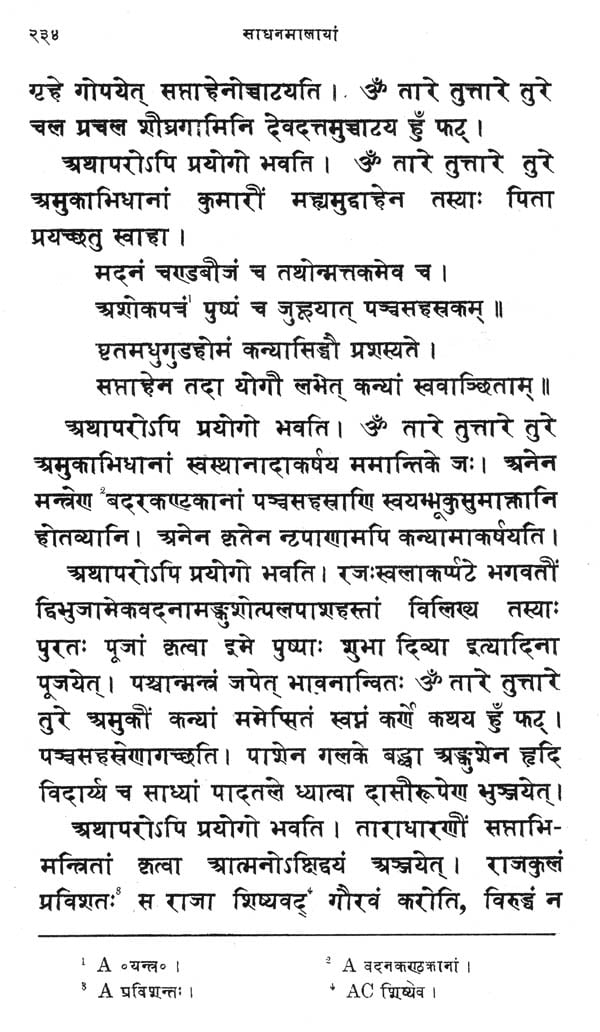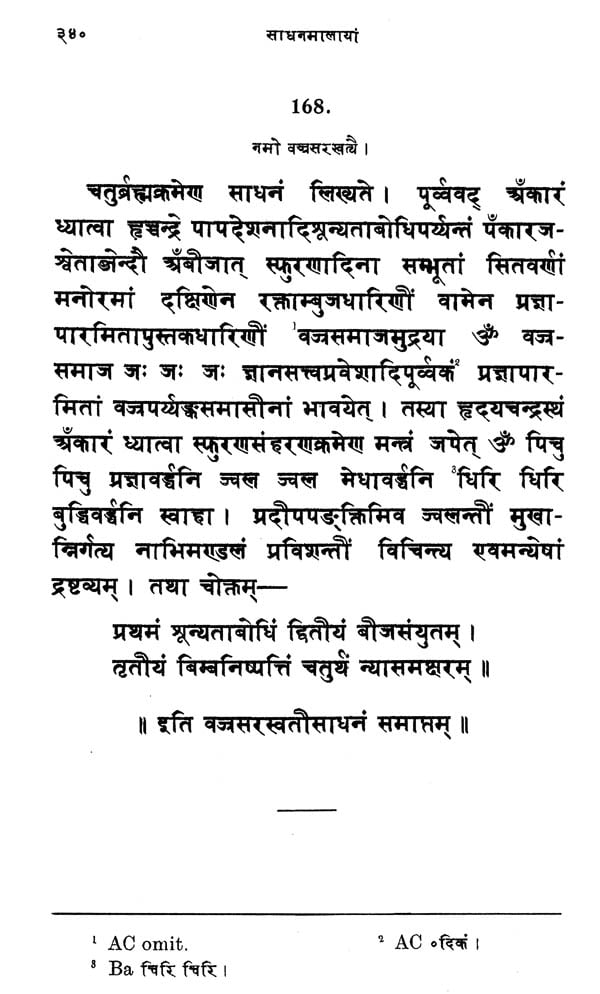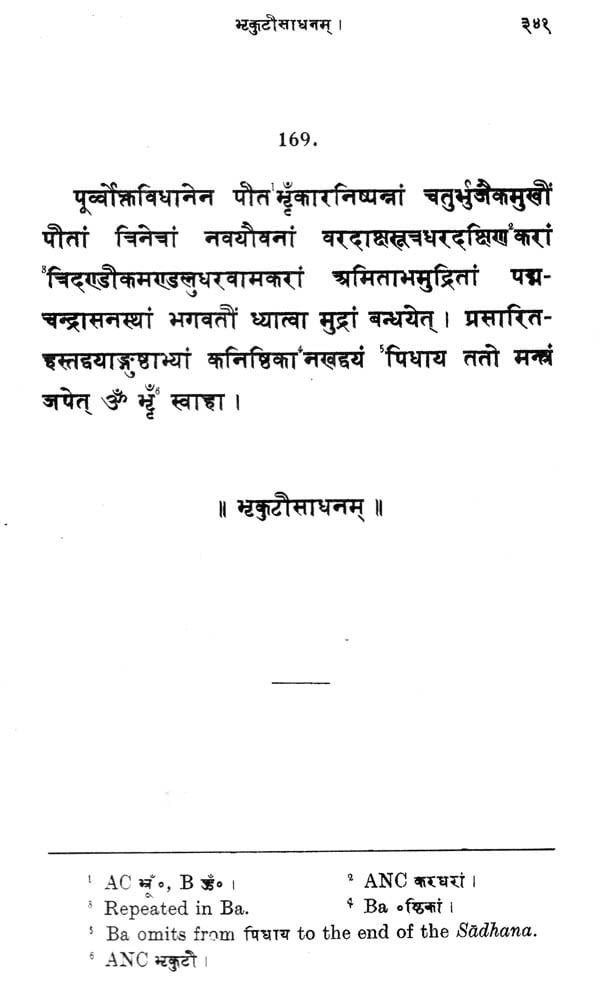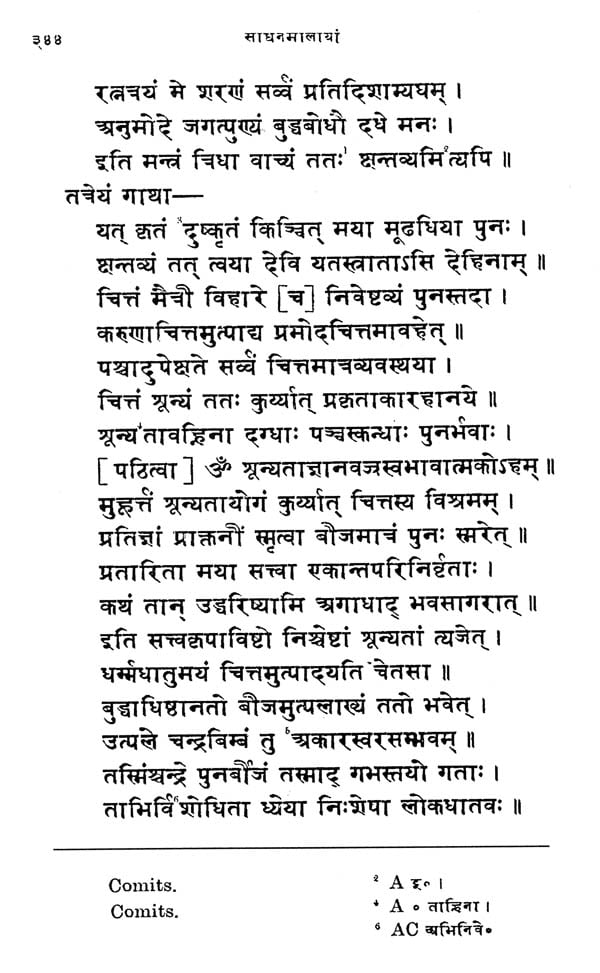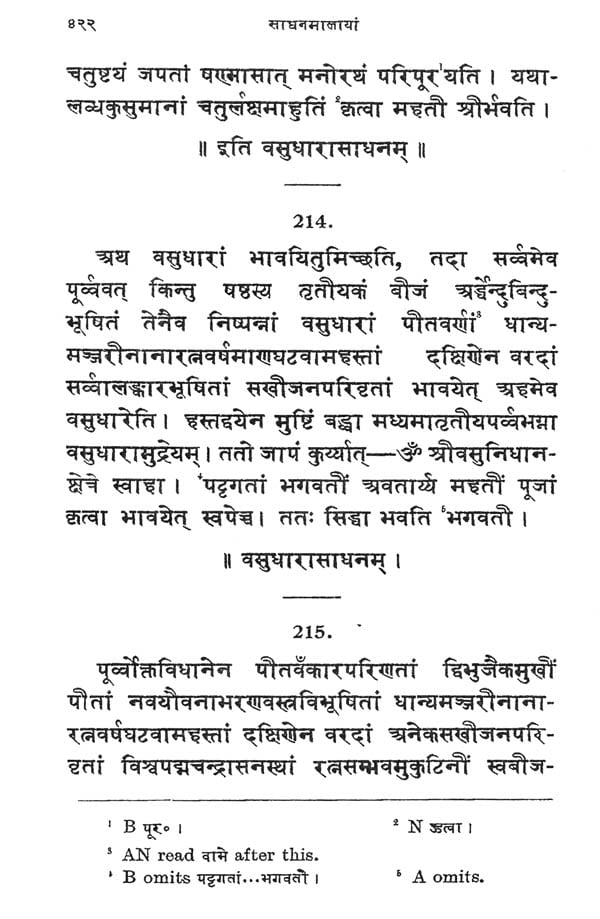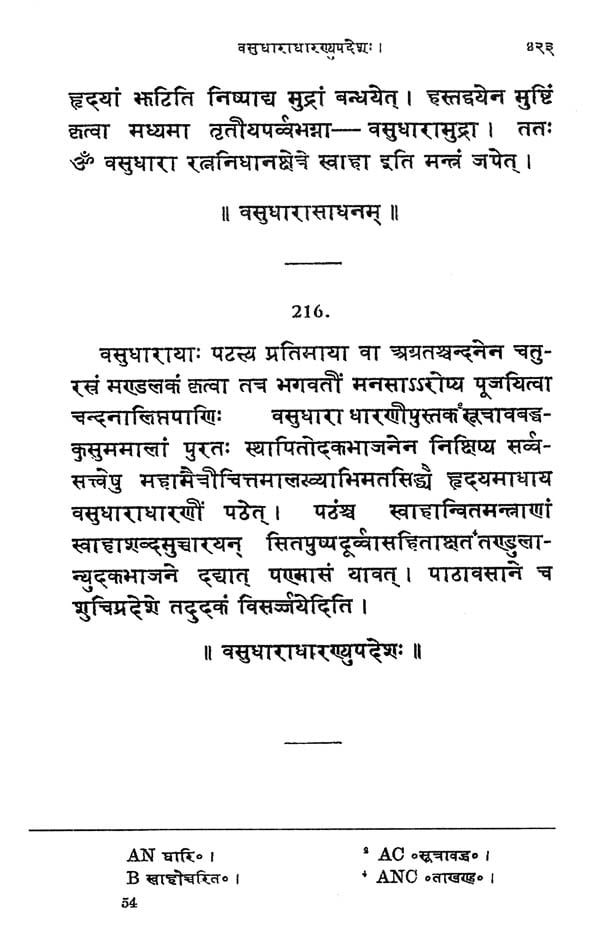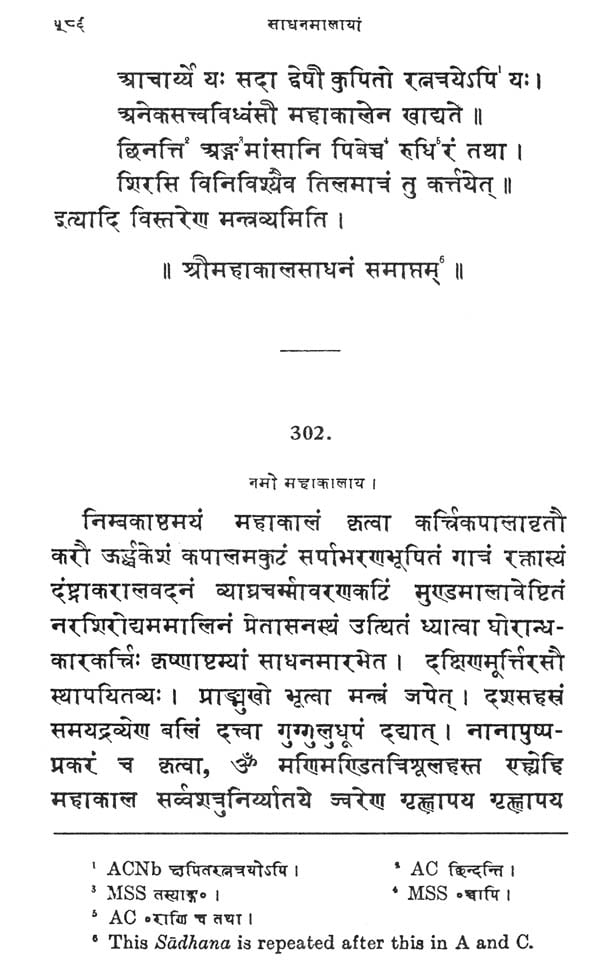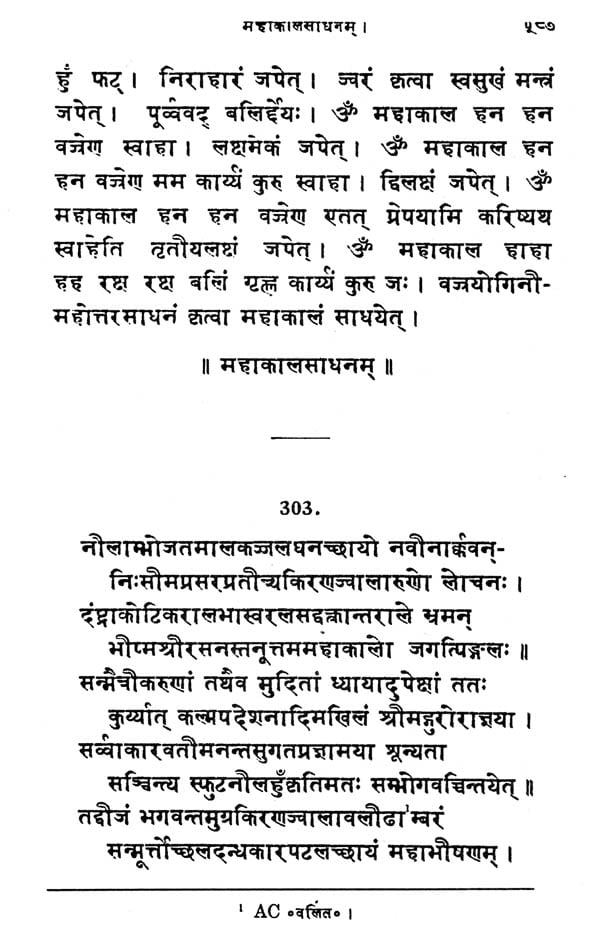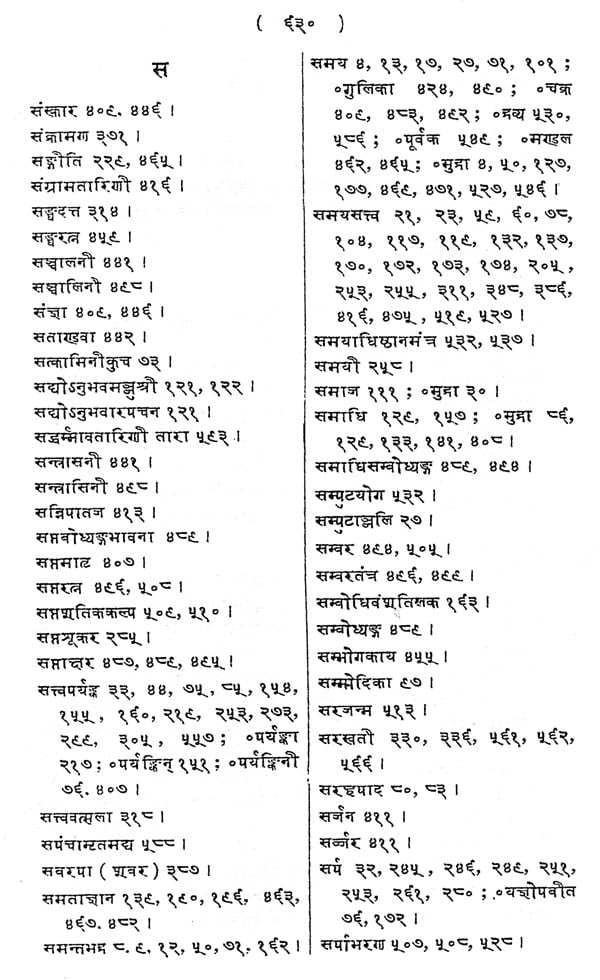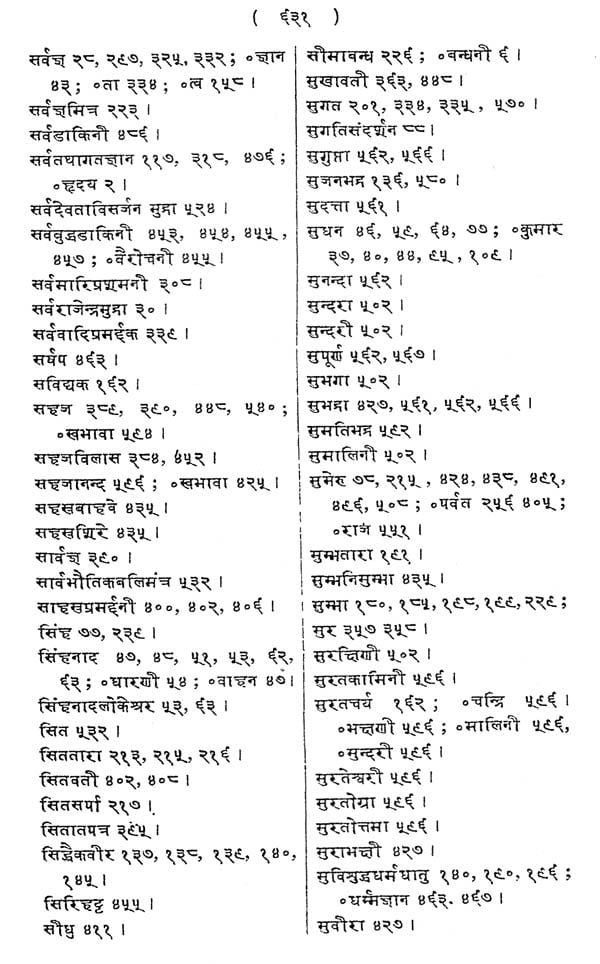
Sadhanamala ( Set of 2 Volumes )
Book Specification
| Item Code: | NAU143 |
| Author: | Bhattacharyya Benoytosh |
| Publisher: | Oriental Institute, Vadodara |
| Language: | ENGLISH & SANSKRIT |
| Edition: | 2009 |
| Pages: | 817 |
| Cover: | HARDCOVER |
| Other Details | 10.00 X 8.00 inch |
| Weight | 2.01 kg |
Book Description
The work Sadhanamala as the title itself suggests, is a compilation of several Sadhanas or Buddhist Tantric rituals, composed by different authors. It belongs to little known branch Vajrayana of Buddhism. It was edited by the great scholar of Buddhism and First Director of our Institute Dr. Benoytosh Bhattacharyya, on the basis of eight Manuscripts, collected and collated for the said purposes. The Sadhanas, not only prescribe rituals for worshipping the deities, but also prescribe numerous Mudras. The importance of the work can be understood from the great demand of this book from the scholars world over and its repeated reprints. This work entitled Sadhanamala Vol. | was first published as Gaekwad’s Oriental Series No. XXVI in 1925. It was first reprinted in 1968.The Reprinted volume has again gone out of stock and hence it is now once again reprinted by Modern methods of scanning and printing. The second volume of the Sadhanamaila will also be reprinted in near future.
The work Sadhanamaia as the title itself suggests, is a compilation of several Sadhanas or Buddhist Tantric rituals, composed by different authors. It belongs to little known Vajrayana branch of Buddhism. It was edited by the great scholar of Buddhism and First Director of our Institute Dr. Benoytosh Bhattacharyya, on the basis of eight Manuscripts, collected and collated for the said purposes. The Sadhanas, not only prescribe rituals for worshipping the deities, but also describe numerous Mudras. The importance of the work can be understood from the great demand of this book from the scholars world over and its repeated reprints.
It gives me great pleasure to present to the world of scholars this work Sadhanamald Vol.1, which was first published as Gaekwad’s Oriental Series No. XXVI in 1925. It was reprinted in 1968. The Reprinted volume has again gone out of stock and hence it is now once again reprinted by Modern methods of scanning and printing. The second volume will also be reprinted in near future.
We are thankful to the University Authorities for sanctioning the required grant for reprinting the book. We thank Dr. Ramanath Pandey, Research Officer and Dr. Mrs. Sharmila Bagchi, Temp. Research Officer for their co-operation in proof-reading the preliminary and preface pages. We also are grateful to Shri P.N. Shrivastava, Manager, the M. S. University Press and his co-operative staff for quick and neat printing of the book.
We are sure that the book will be well-received by the scholars and students interested in the subject.
HIS HIGHNESS MAHARAJA Dr. SIR SAYAJIRAO GAEKWAD, G.C.S.1., G.C.LE., LL.D., in the course of his Memorable Address delivered before the Convocation of the Benares Hindu University on the 19th January, 1924, dwelt at length on the necessity of breadth of vision in the field of Indian scholarship, and warned all scholars "to avoid that most terrible of errors, the narrowness of thought, which at the end stifles thought and individuality’. His Highness’s words were not mere words of empty council : he was laying down a principle which he had consistently followed through-out his life. In the matter of scholarship, His Highness’s breadth of vision induced him to institute a thorough examination of the Jain Bhandaras of Jaisalmer and Pattan. This search again led to the discovery of two unique and priceless Buddhist MSS which were long supposed to have been lost to the world in their original Sanskrit. His Highness, in course of the same address, also announced the discovery of these two MSS. The first is the Nyayapravesa of Dinnaga, who is reputed to be the first systemiser of Indian Logic, and the second is the Tattvasangraha of Santaraksita with the Panyjika of Kamalasila. Both these scholars will ever be remembered in Indian history for having introduced Buddhism and Buddhistic culture into Tibet. Great is the achievement consequent on the breadth of vision, which once on the part of the ancient Jainas, led to the preservation of these unique works in their Bhanddras, and again on the part of His Highness, led to the discovery and publication of these works. Furthermore, actuated by his characteristic love of ancient Indian culture, His Highness graciously promised his powerful support to the cause of Buddhist and Jain studies in his State. An ardent lover and keen student.of comparative religion he realised the lack of published materials for further researches in Buddhism and Jainism.
In pursuance of His Highness’s wishes in the matter of Buddhistic studies, several new Buddhist works have been undertaken for publication in the Gaekwad’s Oriental Series, besides the Nydyapravesa and the T, attvasangraha already referred to. The most important among them are the Sadhanamala, Advayavajrasangraha, Jndnasiddhi of Indrabhiti, Prajnopayaviniscayasiddhi of Anangavajra and the Tarkabhasa of Moksakaragupta.
The Sddhanamala being somewhat voluminous, it is proposed to issue it in two volumes, the first of which is now presented to the Sanskritists. This book belongs to a little known branch of Northern Buddhism called the Vajrayana. The importance of the work was rightly recognised by the authorities of the Bibliothica Buddhica Series of St. Petersburg, who took up the work for publication over 11 years ago but had to abandon their activities during the great war and the subsequent Russian Revolution.
The introduction to the second volume of this work will give full details of the Sadhanamala and of the Vajrayana system of Buddhist philosophy with a history of the literature and notices of the important authors mainly. In this volume, we will endeavour to explain a few salient features of the work which may enable our readers to follow the text with greater ease and satisfaction.
The Sadhanamald is, as the title indicates, a collection of short works called Sadhanas or rituals for worshipping deities. It appears to be heterogeneous collection of Saddhanas, composed by different authors, without any definite plan, as can be seen from a glance at the synopsis of contents. The work begins with two Sadhanas for Trisamayaraja, who is to be identified with Amoghasiddhi, one of the five ~ Dhyani Buddhas. They are followed by three Sddhanas of Vajrasana Buddha who is generally confounded with Gautama Buddha, but who, as a matter of fact, is none other than the Dhyani Buddha Aksobhya himself. Only one Sadhana (No. 3) in a single MS gives the Namaskara as :-
but as his Vijamantra is "Hirth" the Vijamantra of Aksobhya, and as the Sadhana No. 3 (p. 18, 1. 17)describes Vajrasana as Aksobhya and also as he shows the Bhimisparsa Mudra or the Mudra of Aksobhya, it is clear that Vajrasana and Aksobhya must obviously be the same. Aksobhya gets the epithet of Vajrasana as his Ladfcchanda is the Vajra and as he sits in the Vajraparyanka attitude. The Sadhanas of Vajrasana are succeeded by a number of Sadhanas devoted to the different varieties of AvalokiteSvara, the All-Compassionate Bodhisattva, who, according to Karandavytha, refused salvation, though fully entitled to it, until all creatures of the Universe were in possession of the Bodhi knowledge. Thirty- seven Sadhanas (6-43) are devoted to his various manifestations, namely, Sadaksari Lokegvara, Lokanatha, Halahala, Vajradharma, Khasarpana, Simhanada, PadmanartteSvara, Harihariharivahanodbhava, Trailokyavasankara, Nilakantha, Mayajalakrama-LokeSsvara SugatisandarSana and Pretasantarpita. The Sddhanas of Avalokitesvara are followed by 41 Sadhanas (44-84) devoted to the different forms of MafyuSri, namely, Sthiracakra, Vadirat, Mafijughosa, Arapacana, Vajrananga, Dharmadhatuvagisvara, Vak, Siddhaikavira, Maharajalila-Mafijusri, Alimanmatha, Vajratiksna, Dharmasankhasamadhi-Mafjusri, Namasangiti, and Mafijuvajra. Sddhanas of MafiyuSri are again followed by four Sddhanas (85-88) ascribed to another Bodhisattva, Candamaharosana, the principal figure in the Tantra of the same name. Then follow the Sddhanas for the worship of a long series of female divinities, who are generally designated by the name of Tara though the method of their worship and their outward forms differ widely from one another. The Sddhanas from No. 89 right up to the end of this volume are devoted to the worship of these female divinities, namely, Khadirvani Tara, Mahattari Tara, Varada Tara, VasSya Tara, Vajra Tara, Astamahabhaya Tara, Mahacina Tara, Mrtyuvaficana Tara, Sita Tara, Sadbhujasukla Tara, Janguli Tara, Dhanada Tara, Sragdhara Tara Durgottarini Tara, ViSvamata, Prasanna Tara, Arya Tara, Mahasri Tara, Vidyujjvalakarali (a form of Ekajata) Ekajata, Cunda, Marici, Prajiiaparamita, Sarasvati and Bhrkuti. Different kinds of manifestations, each with its different form and colour and individual procedure of worship, can also be observed from the Sddhanas ascribed to them. This is, then, in short, the plan, if indeed, the methods employed can be said to show any plan.
The work Sadhanamala as the title itself Suggests, is a compilation of several SGdhanas or Buddhist Tantric rituals, composed by different authors. It belongs to little known branch Vajrayana of Buddhism. It was edited by the great scholar of Buddhism and First Director of our Institute Dr. Benoytosh Bhattacharyya, on the basis of eight Manuscripts, collected and collated for the said Purposes. The Sadhanas, not only prescribe rituals for worshipping the deities, but also prescribe numerous Mudras. The importance of the work can be understood from the great demand of this book from the scholars world Over and its repeated reprints.
It gives me great pleasure to present to the world of Scholars this work entitled Sadhanamala Vol. I, which was first published as Gaekwad's Oriental Series No. XXVIin 1925. It was first reprinted in 1968. The Reprinted volume has again gone out of stock and hence it was once again reprinted by Modern methods of scanning and printing in 2110. The Second Volume of the Sadhanamala is being reprinted herewith.
We are thankful to the University Authorities for Sanctioning the required grant for reprinting the book. We are thankful to Dr. Milind Josh; and Shri Manoj Upadhyaya for their co-operation in reprinting this book. We also are grateful ‘to Shri P. N. Shrivastav, Manager, University Press and his co- operative staff for quick and neat printing of the book.
We are sure that the book will be well-received by the scholars and students interested in the subject.
Tie second and the concluding volume of the Sadhana- mala is now presented to the public as No. XLI in the Gaekwad’s Oriental Series. The first volume published in 1925 contains 170 Sadhanas while this embodies 142 making a total of 312 Sadhanas. These are all short works of Tantric authors the names of whom in some cases only are known, while in others they are not known. This volume contains in accordance with our nromise an introduction dealing with the problems connected with Vajravina and a general index.
The second volume opens with a series of Sadhanas (Nos. 171-190} devoted to the worship of Kurukulla in a variety of forms. Kurukulla is followed by Usnisa- vijaya (191), Sitatapatra (192), and Vajracarcika (193). Then come the five great protectresses, or Paiicama- haraksa deities as they are called, beginning with Maha- pratisara, to whom three Sidhanas (194-96) are ascribed. She is followed in quick succession by the other great protectresses, namely, Mahamayiri (197), Mahasahasra- pramardani (198), Mahimantraousarini (199), and Maha- sitavati (200). ‘These deities are very popular even now in Nepal and every devout Buddhist is required to keep a MS of Parcaraksa in which directions to worship these goddesses along with their appropriate Mantras are given. The next Sadhana (201) is also devoted to the Maha- raksa deities, but this is in a shorter form than the one that comes after under No. 206. The intervening Sadha- nas are ascribed to Mahapratyangiré (202), Dhvajagra- keyiira (203), Aparajita (204), and Vajragandhari (205). Three Sadhanas are then reserved for the worship of Vajragrmkhala (207-09). Her Sadhana is followed by one of Dhvajagrakeyira (210), and two of Usnisavijaya, one in prose (211) and the other in verse (212). Vasu- dhara the consort of Jambhala comes next and the popularity of the goddess is shown by the attribution of no less than four Sidhanas (213-16) to her worship. Vasudhara is closely followed by another most powerful and popular goddess known as Vajravarahi who forms the subject-matter of an authoritative Buddhist Tantra. No less than eleven (117-127) Sadhanas are attributed to Vajravarahi who is recognized also by the names of Parjfialoka and Jvalamukhi when worshiped in different Mandalas. Nairatma, an emanation of Aksobhya then appears and to her four Sédhanas (128-131) are ascribed. Vajrayogini the next goddess is also a powerful and awe-inspiring deity, and she is the subject- matter of an authoritative Buddhist Tantra known as the Vajrayoginitantra; to her worship there are seven Sadhanas (132-138) in the Sadhanamala. Then follows a series of Sddhanas devoted to the worship of Heruka who is probably the mightiest god in the whole pantheon and is the subject of a popular Tantra entitled the Herukatantra. Heruka is conceived in a variety of _ forms and to each of these forms several Sadhanas are attributed. Mahamaya or the four-faced and the four- armed Heruka has two Saédhanas (239-240); the two- faced Heruka with or without the Sakti has nine (241— 949); while Vajradika or the three-faced and six-armed Heruka, who is also called Saptaksara, because of the seven-syllabled Mantra ascribed to him, has the two next Sadhanas (250-251). The two subsequent Sadhanas (252-253) deal with the processes of Bahyapuja (external worship) and Hastapija (worship with hand) of Cakrasamvara a form of Heruka who is ‘so called when he takes the Sakti Vajravarabi; the union of the two is the subject-matter of the Cakrasamvara- tantra. The next Sadhana (254) is devoted to the worship of Buddhakapala who is none but Heruka himself with four arms and represented as united in Yoga with his Sakti Citrasena. This also is the subject-matter of yet another Tantra by name Buddhakapilalanira. The last Sidhana (255) in the Heruka sories is again devoted to the worship of Cakrasamvara or Heruka who is associated with his Sakti Vajravarihi. The next Sidhana (256) gives four ono-syllabled Mantras and explains the results obtainable therefrom. Then come Vajrahunkira (257) and Mahabale (258) to each of whom one Sadhana is ascribed. To Hayagriva, also enlled Paramasva, no less than threo Sadhanas (259- 61) are ascribed. while the two subsequent ones Trai- lokyavijaya (262) and Vajraj vilanalirka (263) get only one Sadhana each. Several Sidhanas then follow for the worship of a rather fearful but popular deity named Bhitadimara (264-67) who in his turn followed by another popalar Vajrayana deity known as Yamari or Yamantaka with a red or blue form: to the latter no less than thirteen (268-280) Sidhanas, some in prose and a large majority in verse, are devoted. The deity who follows next is Vighnantaka and is rather unfortu- nate to get only one Sadhana (281) squeezed in between a Sadhana of Yamintaka and his Balimantra (282).
Maitreya the future Buddha to whom only one Sadhana (283) is given shows vividly the apathy displayed towards this mighty personality of primitive Buddhism by the Vajrayainists. The case of J ambhala the god of wealth, however, is different, and the cagerness with which this Buddhist Mammon was worshipped is indicated in the sixteen Sidhanas (284-299), some in prose and others in eloquent verse, contained in the book. Then follow seven Sadhanas (300-306) for the worship of a fierce god Mabakala who is also concefved in a variety of forms. Mahakala is followed by Ganapati who, though originally Hindu, readily found o place in the Vajrayana pantheon; to him one Sadhana is awarded. Rajaégri Tara comes next (308) and the subsequent Sadhana (309) contains a panegyric of the same goddess. She is followed by Pitha Tara in one Sadhana (310), while the next (311) gives the JZalamanira of the same deity. The last Sadhana (312) in this volume and in the Sadhanamala is ascribed to Mahahala whose Mandala with all attendant deities is described in detail.
